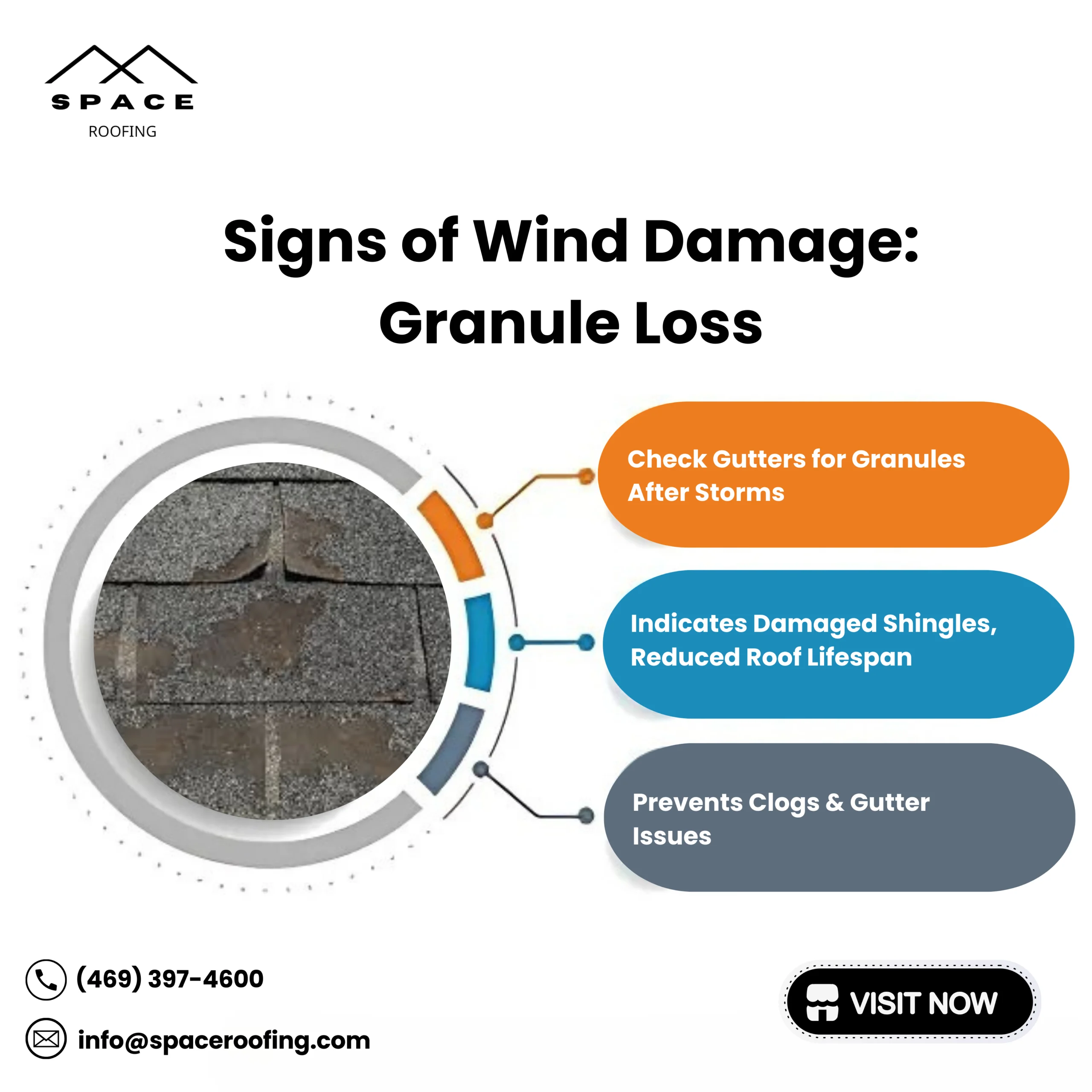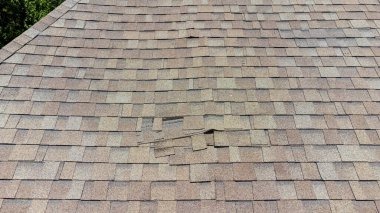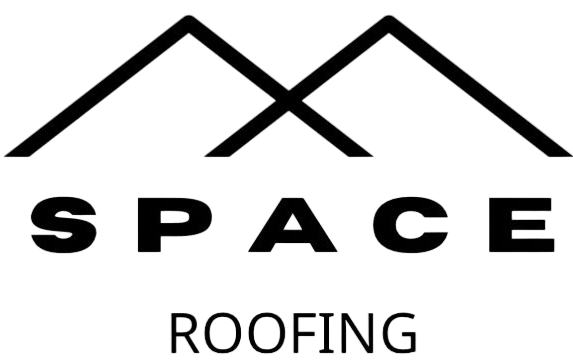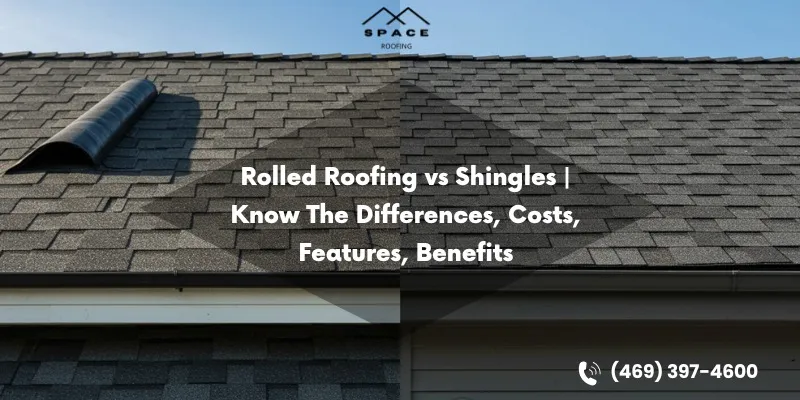High winds can wreak havoc on your roof, leaving it vulnerable to leaks and structural issues. Understanding what does wind damage look like on a roof is crucial for timely repairs. From missing shingles to interior leaks, here are the key indicators and solutions to safeguard your home from wind damage.
Top Signs of High Winds Damage Your Roof
There can be numerous reasons for roof damage due to winds. Here are a few of the most frequent reasons for roof damage:
Missing or Damaged Shingles

One of the most apparent signs of wind damage on the roof is missing or damaged shingles. High winds often lift or completely remove shingles, especially if they are not securely fastened. Shingle damage from wind can expose the underlying layers of your roof, making it more prone to water damage.
Additionally, extensive shingle damage may necessitate a roof replacement, significantly impacting the overall roof replacement cost. Wind damage to shingles might also appear as cracked or torn edges, especially after storms with damaging wind speeds, further influencing the decision between repair and replacement based on the associated costs.
Debris on the Roof

Strong winds often carry debris that lands on your roof. This debris can cause wind-damaged shingles or punctures on the roof’s surface. If you notice tree branches or other objects on your roof after a storm, inspect for hidden roof damage from wind.
Granule Loss

Granule loss is a subtle but significant indicator of wind damage to roofing. Check your gutters and downspouts for granules washed away during a storm. Wind-damaged roof shingles often lose granules, exposing them to the elements and reducing their lifespan.
Additionally, the accumulation of granules in your gutters can lead to clogs and reduced efficiency, potentially necessitating the cost to install new gutters. Addressing granule loss promptly not only helps preserve your roof’s integrity but also minimizes the need for costly gutter replacements, ensuring your home remains protected from water damage.
Soffit and Fascia Damage

The soffit and fascia are critical parts of your roof’s structure, protecting it from weather elements. Strong winds can loosen or tear them away, leading to roofing wind damage. Roof wind damage repair might be necessary to restore the structural integrity of your roof.
Curling or Buckling Shingles

Curling or buckling shingles are a warning sign of wind damage to roof shingles. High winds can lift the edges of shingles roofing, leaving them vulnerable to further damage or detachment.
Over time, this can lead to widespread roof damage wind across your home. It is best to address these issues on time before they become serious problems that will add to the cost and create an issue when the repair work begins.
Interior Signs of Wind Damage

Not all signs of wind damage to roofs are visible from the outside. Check for water stains, cracks, or peeling paint on your ceilings and walls. These are often signs of a leaky roof caused by wind roof damage.
Interior signs of wind damage can be worse as they are not visible openly, and you might ignore them for a long. As a result, the damage keeps growing, and then there comes a time when you require an emergency solution. To avoid these emergency costs, watch any stains of seeping water or cracks that may appear near the roof.
Leaky Roof

A common result of wind-damaged roofs is leaks. Water can seep into your home if high winds have displaced flashing or shingles. Addressing roof damage and wind repair promptly can prevent costly interior damage. Wind-damaged shingles are a problem that may result in leaks. Moreover, wind and hail damage to a roof can cause leaks.
Damaged Flashing

Flashing around chimneys, vents, and skylights is susceptible to wind damage roof repair needs. Displaced or bent flashing can allow water to penetrate your roof, leading to significant issues over time.
If you experience speedy winds, the flashing can get damaged within a short period, and the repair work can take long. It is best to consult the best professional repair teams near you to get the best solution in time.
How Do Different Wind Speeds Impact Your Roof?
Wind speeds greatly influence the extent of roof damage from wind. Here’s a breakdown:
Can 40 mph winds cause damage? Light winds like these can loosen shingles or displace unsecured parts of your roof. If you ask, what can 50 mph winds damage?
Moderate winds can cause shingles wind damage, especially if they are ageing or poorly installed. 60 mph wind gust damage is problematic since strong winds can rip shingles off entirely, leading to storm-damaged roofs.
Similarly, 75 mph wind damage can cause structural damage, necessitating a full roof replacement in some cases. What can 80 mph winds do? Severe winds can tear apart professional roofing materials, exposing significant portions of your roof. Consulting a wind damage chart can help gauge the risks and prepare your home better for storms.
Is Wind Damage To Roofs Covered By Insurance and How To Claim?
In many cases, roof damage wind is covered by homeowner’s insurance. The key is to document the wind-damaged roof with photos and a detailed inspection report. Pictures of wind-damaged shingles can serve as valuable evidence.
To file a claim, you must contact your insurance provider immediately. They will ask you to provide a detailed description of the wind and hail damage to the roof, along with photos.
Once you have submitted the required evidence, you will work with a professional roofing contractor to assess the extent of wind damage roof repair needed. Understanding how much wind damage to replace the roof and your policy coverage can streamline the claims process.
Wind Damage Repair by Space Roofing

Space Roofing is the best solution provider for wind-damaged shingles and restoring damaged roofs. Whether it’s repairing wind-damaged shingles or addressing severe wind-damaged roofing, their team provides expert solutions to ensure your home’s safety.
For homeowners wondering, “How much wind can a roof withstand?” or needing immediate assistance with wind damaged roof shingles, Space Roofing is your last resort for the best results. Protecting your home from wind damage today involves regular roof inspections, prompt repairs, and understanding the signs of damage.
Whether it’s a mild shingle wind damage or severe issues from 75 mph wind damage, taking action early can save you time and money. So call today and find out all you need about wind damage and roof repairs.
FAQs
1. What are the common signs of wind damage to a roof?
Common signs of wind damage to a roof include missing or damaged shingles, granule loss, debris on the roof, curling or buckling shingles, and soffit or fascia damage.
2. How do I know if my roof has suffered wind damage?
Look for visible signs like missing shingles, granule loss, or debris on the roof. Inside your home, check for water stains, cracks, or peeling paint, which may indicate leaks caused by wind damage.
3. Can 50 mph winds damage my roof?
Yes, 50 mph winds can cause significant damage to older or poorly installed shingles. Strong gusts can dislodge shingles or lift them, exposing the underlying roof layers to water damage.
4. Is wind damage to roofs covered by homeowner’s insurance?
Wind damage to roofs is often covered by homeowner’s insurance. Document the damage with photos, and contact your insurer promptly to file a claim and begin the repair process.
5. How can I prevent wind damage to my roof?
Regular roof inspections, securing loose shingles, and maintaining proper flashing are key preventive measures. Upgrading roofing materials and ensuring proper installation can also help reduce the risk of wind damage.





